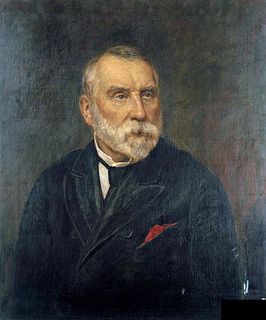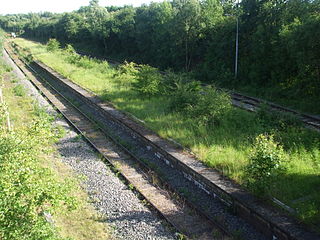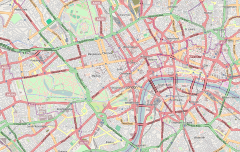
Marylebone station is a Central London railway terminus and connected London Underground station in the Marylebone area of the City of Westminster. On the National Rail network it is also known as London Marylebone and is the southern terminus of the Chiltern Main Line to Birmingham. An accompanying Underground station is on the Bakerloo line between Edgware Road and Baker Street in Transport for London's fare zone 1.

Sir Edward William Watkin, 1st Baronet was a British Member of Parliament and railway entrepreneur. He was an ambitious visionary, and presided over large-scale railway engineering projects to fulfil his business aspirations, eventually rising to become chairman of nine different British railway companies.

Euston Road is a road in Central London that runs from Marylebone Road to King's Cross. The route is part of the London Inner Ring Road and forms part of the London congestion charge zone boundary. It is named after Euston Hall, the family seat of the Dukes of Grafton, who had become major property owners in the area during the mid-19th century.

Watkin's Tower was a partially completed iron lattice tower in Wembley Park, London, England. Its construction was an ambitious project to create a 358-metre (1,175 ft)-high visitor attraction in Wembley Park to the north of the city, led by the railway entrepreneur Sir Edward Watkin. Marketed as the "Great Tower of London", it was designed to surpass the height of the Eiffel Tower in Paris, and it was part of Wembley Park's emergence as a recreational place. The tower was never completed and it was demolished in 1907. The site of the tower is now occupied by the English national football ground, Wembley Stadium.

Great Portland Street in the West End of London links Oxford Street with Albany Street and the A501 Marylebone Road and Euston Road. A commercial street including some embassies, it divides Fitzrovia, to the east, from Marylebone to the west. It delineates areas with contrasting identities, the west at strongest in grandiose Portland Place and Harley Street, the east at strongest in artists' and independent businesses of Fitzrovia. The street has its own unique character, due in part of the unusual combination of small shops combined with its strongly rectilinear character.

Denham Golf Club railway station is a railway station near the villages of Baker's Wood and Denham, Buckinghamshire, England. The station is on the Chiltern Main Line between Denham and Gerrards Cross.

Leamington Spa railway station serves the town of Royal Leamington Spa, in Warwickshire, England. It is situated on Old Warwick Road towards the southern edge of the town centre. It is a major stop on the Chiltern Main Line between London and Birmingham, and the branch line to Coventry.

This article describes the hotels in London, England.

High Wycombe railway station is a railway station in the town of High Wycombe, Buckinghamshire, England. The station is on the Chiltern Main Line between Beaconsfield and Saunderton stations. It is served by Chiltern Railways.

Nottingham Victoria railway station was a Great Central Railway and Great Northern Railway railway station in Nottingham, England. It was designed by the architect Albert Edward Lambert, who also designed the rebuild of the Nottingham Midland station.

The Great Central Main Line (GCML), also known as the London Extension of the Manchester, Sheffield and Lincolnshire Railway (MS&LR), is a former railway line in the United Kingdom. The line was opened in 1899 and built by the Great Central Railway running from Sheffield in the North of England, southwards through Nottingham and Leicester to Marylebone in London.

Rugby Central was a railway station serving Rugby in Warwickshire on the former Great Central Main Line which opened in 1899 and closed in 1969. The station was on Hillmorton Road, roughly half a mile east of the town centre.

Calvert was a railway station at Calvert, Buckinghamshire on the former Great Central Main Line between Manchester Piccadilly and London Marylebone. The station was opened in 1899 and closed to passengers in 1963 and goods in 1964. The line through it remains open for freight, including waste to a landfill site.

Edwardian architecture is a Neo-Baroque architectural style that was popular in the British Empire during the Edwardian era (1901–1910). Architecture up to the year 1914 may also be included in this style.

The Jupiter Hotel is a converted, mid-20th century motor inn boutique hotel located in Portland, Oregon, in the United States. It has been described as a "party hotel" and has been compared to the Standard Hotels in Los Angeles.

The Radisson RED Hotel Liverpool is a historic hotel in Liverpool, England, opened in 1871 as the North Western Hotel. It is located on the east side of Lime Street, fronting Lime Street railway station. The building is recorded in the National Heritage List for England as a designated Grade II listed building.

Rose Hill in Longley Lane, Northenden, Manchester, England, is a 19th-century Victorian villa. It is most notable as the home of Sir Edward Watkin, "railway king and cross-channel visionary", and in the late 20th century it was in use as a children’s home.

Hotel Astoria is a design hotel located next to the Central Station in Copenhagen, Denmark. The building is an early example of Functionalist architecture in Denmark.

Hotel Majestic is the historical hotel in Kuala Lumpur, Malaysia. This hotel is located near Kuala Lumpur Railway Station and is part of the Autograph Collection.
Article forked from Lisson Grove.




















